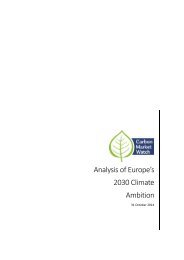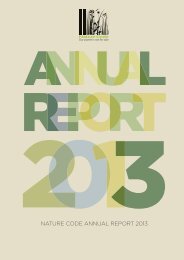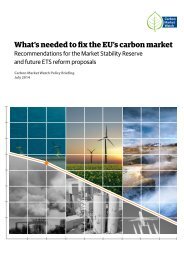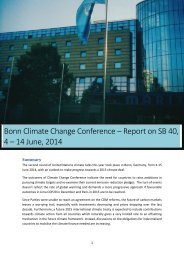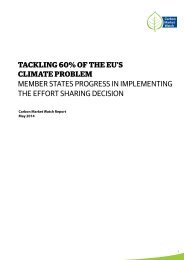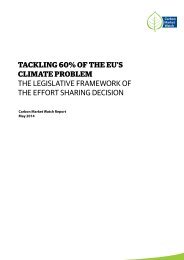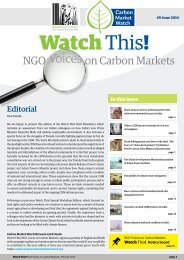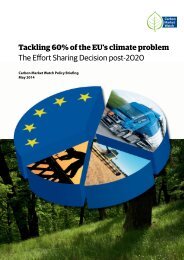THE ROLE OF INTERNATIONAL OFFSETS IN THE FUEL QUALITY DIRECTIVE
You also want an ePaper? Increase the reach of your titles
YUMPU automatically turns print PDFs into web optimized ePapers that Google loves.
In order to address both the quantity and quality problems with<br />
international offsets, the EU progressively phased out carbon<br />
offsets originating from advanced developing countries. Under EU<br />
legislation, credits from new projects registered after 2012 can only<br />
be used in the EU ETS if the projects are located in Least Developed<br />
Countries. The EU has furthermore decided that after 2020 EU’s<br />
climate legislation will no longer depend on the use of international<br />
offsets, but will focus solely on domestic mitigation actions.<br />
Policy recommendations: eligibility criteria for UERs<br />
The FQD’s implementing measure does not contain quality<br />
restrictions on which offsetting projects are allowed to count as<br />
upstream emission reductions. The only restriction is that the<br />
project needs to have been started after 1 January 2011. This<br />
opens the door for non-additional offset credits that do nothing<br />
to improve the life-cycle greenhouse gas intensity of transport<br />
fuels. It will therefore be up to the Commission to provide guidance<br />
to Member States as regards to which offset quality criteria they<br />
should include in their national legislation to ensure that UERs lead<br />
to real emission reductions.<br />
A report commissioned by the European Commission entitled “The<br />
reduction of upstream greenhouse gas emissions from venting and<br />
flaring” lists 6 principles to which eligible offsetting systems should<br />
conform “in order to promote quantifiable and reliable climate<br />
change mitigation” (restricted to flaring and venting projects):<br />
1. Additionality need to be demonstrated to ensure that credited projects would not have been expected to happen in a<br />
business-as-usual baseline case. The assessment of additionality by independent auditors should reflect both economic and<br />
regulatory factors.<br />
2. There should be data transparency to eliminate double counting across Member States. There is a need for a system that<br />
ensures that any offsets can only be redeemed in one Member State.<br />
3. There should be a risk based approach to fraud. If it is impossible to have confidence that reported savings are real and<br />
accurate, certain categories of projects should be excluded from crediting.<br />
4. Credits should only be given to gas that is captured and utilized. The emission reductions from the projects should be based<br />
on the quantity of associated petroleum gas successfully brought to the market instead of being flared or vented. Reductions in<br />
flaring at a given well do not give an accurate picture, as rating of flaring may be subject to natural variations.<br />
5. There should be continuous measurements at multiple points of the rates of gas delivery to the market.<br />
6. All projects should be subject to verification by competent auditors from design to implementation.<br />
The use of offsets for a key EU transport policy must address the<br />
concerns outlined in this paper and should be improved in the<br />
following ways:<br />
- The offsetting project should have started after 1<br />
January 2013, so that only new and additional projects<br />
that reduce emissions from flaring and venting are used<br />
for compliance.<br />
- Additionality is ensured by requesting supplementary<br />
additionality assessments to prove that reductions are<br />
expected to be additional to business as usual scenario,<br />
taking into account national policies (project is not<br />
required under local laws and regulations), financial<br />
revenues (project is not financially attractive without<br />
credit support) and initiatives such as the Global Gas<br />
Flaring Reduction Partnership.<br />
- Double counting between Member States is avoided by<br />
establishing or using a central European database.<br />
- Double counting between the EU and third countries<br />
is avoided, by ensuring that credits that are used to<br />
comply with the FQD are not also redeemed in any other<br />
country or region in the world.<br />
- Double counting between the FQD and the EU ETS is<br />
avoided, by putting in place additional safeguards to<br />
ensure that oil companies cannot use the same offsets<br />
for compliance with both the FQD and the EU ETS.<br />
- Full transparency from fuel suppers is required about<br />
the issuance year, quantity, type, serial number and origin<br />
of offsets used.<br />
- Only venting and flaring 17 projects are eligible for<br />
UERs. Currently, the flaring of natural gas releases over<br />
400 million metric tonnes of carbon dioxide equivalent<br />
(CO2e) emissions globally every year, which is comparable<br />
to the annual emissions from 125 medium-sized (63<br />
gigawatt) coal plants in the USA (Farina, 2010) or the<br />
entire emissions of France 18 . There is hence significant<br />
mitigation potential to reduce emissions from venting<br />
and flaring.<br />
Upstream emission reductions should be limited to CDM<br />
projects in Least Developed Countries (LDCs). This ensures<br />
consistency with the existing EU restrictions on international<br />
offsets. Under EU’s climate legislation, credits from new projects<br />
registered after 2012 can only be used by companies under the EU<br />
ETS if the projects are located in Least Developed Countries. The<br />
same restrictions should apply to oil companies covered by the Fuel<br />
Quality Directive.<br />
10




